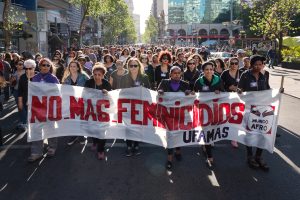
Included in the essay collection Tsumani 2 (Sexto Piso, 2020), “Feminism without a Room of One’s Own,” by the Mexican writer Dahlia de la Cerda addresses the differences among successful feminist groups in Mexico that, nevertheless, do not consider other feminist groups in situations of genuine oppression. “It is important to point out these differences because not all women are oppressed; some experience discrimination and gender violence but are not oppressed” (89).
This applies not only to feminist movements in Mexico and Latin America, but also to indigenous communities and precarious youth, all of whom nowadays suffer violence stemming from the same neoliberal root.
And in cultural productions addressing these social issues, the same contradiction persists: while some succeed in addressing the causes of the violence they face, the majority profit through seemingly progressive discursive strategies but, fundamentally, align with the neoliberal system.
From the 1990s onwards, with the flourishing of neoliberalism established during the preceding decade, that violence against these three groups got an unknown shape until then. While it is true that these social sectors had been systematically and historically beaten before this period, it is important to remember that the means and ends of violence always depend on their contextual conditions, paraphrasing Foucault.
In the neoliberal stage, whose aim is to maximize the profits of the private sector at all costs and rapidly, violence intensifies against these three specific groups, turning them into the main victims of a particular type of necropolitics experienced especially on the margins of Latin American society over the last three decades.
This course’s theoretical framework comprises the concepts violence as such (Žižek), neoliberalism as an ideology (Harvey), the State as a producer of discourses and meanings (Gramsci, Chaterjee), cultural objects as discourses in dispute (Foucault, Bourdieu), and resistance groups’ symbolization strategies to create horizons of meaning to fight the neoliberal violence (Rancière, Emmelhainz, Zavala, Lund).
This seminar approaches a diversity of discourses, practices, and cultural productions from, and around, these three social sectors —women, indigenous communities, and precarious youth— in order to reflect on both the process of violence they have been facing for decades and their resistance movements. Also, institutional expressions will be analyzed, such as speeches delivered in official events, press releases, as well as art works, like novels, stories, and essays, cinematographic pieces, television, and streaming series.
The reason for considering these three major themes in the same seminar is because of their common denominator: the original source of the violence they have been facing for more than two decades is the neoliberal system.
The establishment of neoliberalism in Latin America as an ideology and principle of social organization, technology of governance, and administrator of violent control mechanisms; all of this has notably originated the conditions of insecurity and precariousness in general and has developed a permanent apparatus of symbolic violence, as this seminar’s participants will be the opportunity to analyze.
